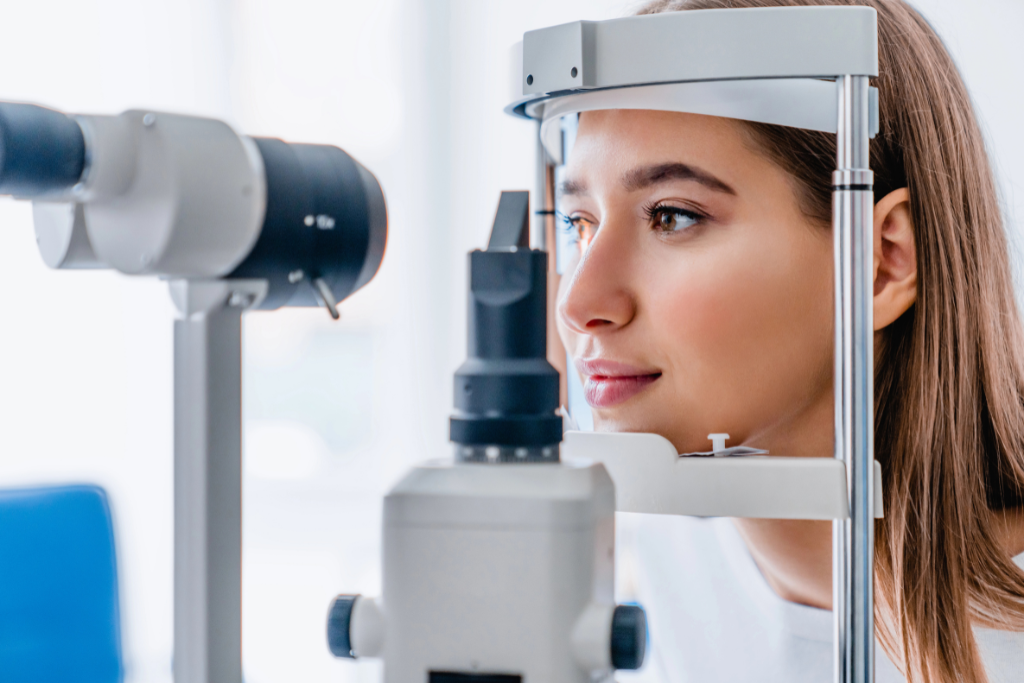We often think of an eye exam as a simple way to update our glasses prescription or check for common vision problems. However, a routine visit to an eye doctor in Los Angeles can be one of the most proactive steps you take for your overall health. The eyes, with their complex network of blood vessels and nerves, serve as a unique and invaluable window into the body’s systemic health. In fact, many serious conditions, such as diabetes and hypertension (high blood pressure), often reveal their first subtle warning signs in the eyes, sometimes long before any other symptoms become apparent.
We’ll explain how a comprehensive eye exam can be a powerful tool for the early detection and prevention of these widespread systemic diseases. Understanding the connection between your eye health and your overall well being is the key to protecting both your vision and your life.
The Eye as a Window Into Overall Health
The human eye is a marvel of biological engineering. At the back of the eye lies the retina, a light sensitive tissue with a remarkable feature: its blood vessels are the only ones in the entire body that can be directly and non invasively viewed by a doctor. An eye doctor can look at these vessels, which are incredibly small and delicate, and see subtle changes that provide direct clues about what is happening in the rest of your circulatory system.
The condition of the retinal blood vessels reflects the health of the blood vessels in other vital organs, including the heart, brain, and kidneys. Why is this so critical? Because systemic diseases like diabetes and hypertension damage blood vessels throughout the body. Therefore, a careful examination of the eye’s internal structures can reveal signs of this damage, even if you feel completely fine. Regular eye exams are not just about seeing clearly; they are a critical component of early disease detection and proactive health management.
Also Read: 5 Mistakes to Avoid When Searching for a Cataract Surgeon in Los Angeles
Signs of Diabetes in the Eyes
When blood sugar levels are consistently high, as is the case with undiagnosed or uncontrolled diabetes, the delicate blood vessels in the retina begin to suffer damage. Eye exams for systemic diseases are a key part of a comprehensive health screening. The initial stage of diabetic eye disease, known as diabetic retinopathy, is a primary indicator. During a diabetic eye exam, your optometrist or ophthalmologist will look for:
- Microaneurysms: These are tiny bulges or balloons that form on the walls of the blood vessels. They are often the earliest visible sign of diabetic damage.
- Hemorrhages and Exudates: As the blood vessels weaken, they can leak blood (hemorrhages) or fluid and fatty deposits (exudates) into the retina. These appear as small spots or splotches on the retinal surface.
- Retinal Swelling (Macular Edema): If blood or fluid leaks into the macula, the central part of the retina responsible for sharp, central vision, it causes swelling. This condition, called macular edema, can lead to blurred vision and, if left untreated, significant vision loss.
These early signs may be present long before a person experiences any changes in their vision. This is why a regular diabetic retinopathy screening is so vital for anyone with a family history or risk factors for diabetes. A skilled eye doctor knows how eye doctors detect diabetes through these telltale signs, enabling a prompt diagnosis and the start of a treatment plan to prevent permanent vision damage.
Signs of Hypertension in the Eyes
High blood pressure, or hypertension, puts constant strain on the body’s blood vessels. Just like with diabetes, the retinal blood vessels are particularly susceptible to this stress. The resulting condition, called hypertensive retinopathy, offers clear hypertension eye signs. An eye exam can detect these changes, which include:
- Arterial Narrowing: The high pressure causes the walls of the small arteries to thicken and narrow, restricting blood flow. This is one of the most common early signs of hypertension in the eyes.
- Arteriovenous (AV) Nicking: Where an artery and vein cross each other, the thickened artery can press on the vein, causing it to look pinched or “nicked.” This is a classic sign of long term, uncontrolled high blood pressure.
- Hemorrhages and Cotton Wool Spots: High pressure can cause the fragile blood vessels to burst, leading to hemorrhages. It can also cause areas of nerve damage in the retina, which appear as small white spots known as “cotton wool spots.”
- Optic Nerve Swelling (Papilledema): In severe or sudden cases of very high blood pressure, the pressure can be so extreme that it causes the optic nerve to swell. This is a medical emergency that requires immediate attention.
An eye exam in Los Angeles is an excellent way to determine if an individual’s high blood pressure is affecting their body’s vascular system. The presence of these hypertension eye signs is a strong indicator that a person needs to see their primary care physician to manage their blood pressure and prevent more serious complications like stroke or heart attack. An eye exam can detect high blood pressure and other systemic problems.
Tools Eye Doctors Use for Detection
Modern eye care utilizes advanced technology to provide an exceptionally detailed look at the eye’s internal structures, allowing for the precise diagnosis of diabetic eye exam and can eye exams detect high blood pressure findings. Your optometrist near me will likely use several key tools:
- Dilated Eye Exam: This is a fundamental part of a comprehensive exam. Eye drops are used to widen the pupils, giving the doctor a much clearer and wider view of the retina and optic nerve. This simple procedure is essential for spotting the earliest signs of systemic disease.
- Fundus Photography: This tool captures highly detailed, high resolution photographs of the back of the eye. These images serve as a baseline and allow the doctor to precisely track any changes to the blood vessels over time.
- Optical Coherence Tomography (OCT): This is a non invasive imaging test that uses light waves to take cross sectional images of the retina. It’s particularly useful for detecting and measuring the retinal swelling (macular edema) that is a hallmark of diabetic retinopathy.
- Fluorescein Angiography: In some cases, a special dye is injected into the arm, which travels to the blood vessels in the eye. A camera then takes rapid photos as the dye fills the vessels, highlighting any blockages, leaks, or areas of damage.
Also Read: When a Red Eye Isn’t Just Dryness: Spotting a Pterygium Early
Why Early Detection Matters
Catching diabetes or high blood pressure early, before they cause significant damage, is the key to managing these chronic conditions effectively. Eye findings may be the very first sign of an undiagnosed systemic illness, making the eye doctor a necessary frontline health provider. When an eye doctor in Los Angeles detects these signs, they can immediately refer the patient for a blood test, a physical exam, or a consultation with a primary care doctor. This swift action can:
- Prevent Vision Loss: By catching diabetic retinopathy or hypertensive retinopathy in its initial stages, treatment can be started to save vision and prevent irreversible damage. This is why diabetic retinopathy screening is so important.
- Prevent Systemic Complications: The damage seen in the eye is a red flag for damage elsewhere in the body. An early diagnosis of diabetes or hypertension can lead to treatment that prevents devastating complications such as stroke, heart disease, kidney failure, and nerve damage.
What Happens After Detection
Once a doctor identifies early signs of hypertension in the eyes or signs of diabetes, they will not only inform you but will also take action. Your eye doctor will communicate their findings and a referral to your primary care physician for a systemic evaluation. This is not a formal diagnosis of the disease itself, but rather an important indicator that further testing is needed. The eye care team at Soroudi Advanced LASIK and Eye Centers works in close collaboration with other medical professionals, including primary care doctors, endocrinologists, and cardiologists, to ensure a coordinated approach to your care. Continued monitoring of your eye health will also be recommended to track how well your systemic disease is being controlled.
Preventive Care and Patient Responsibility
Taking charge of your health is a partnership between you and your healthcare providers. Here’s what you can do to protect your vision and your overall health:
- Schedule Regular Eye Exams: Make annual comprehensive eye exams a part of your routine healthcare, especially for adults over 40 or those with a family history of diabetes or high blood pressure. A quick search for an optometrist near me will provide you with local options for a thorough screening.
- Manage Your Health: If you have already been diagnosed with diabetes or hypertension, follow your doctor’s recommendations for managing your blood sugar and blood pressure through diet, exercise, and medication.
- Follow Up: Take your eye doctor’s recommendations seriously and follow up with the appropriate primary care or specialist appointments.
Conclusion
An eye exam is much more than a vision test. It’s a powerful health screening tool that can detect the early signs of serious systemic conditions like diabetes and hypertension before you even realize anything is wrong. By meticulously examining the blood vessels in the retina, an eye doctor can provide life saving insights into your overall health.
Don’t wait for symptoms to appear. A simple, comprehensive eye exam can save both your sight and your life by catching these diseases early. If you are looking for an expert eye doctor in Los Angeles you can rely on, contact Soroudi Advanced LASIK and Eye Centers to schedule your regular eye exam, even if your vision seems perfect. It’s the smartest step you can take for your long term health.



